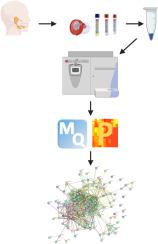Journal of Proteomics ( IF 2.8 ) Pub Date : 2020-10-14 , DOI: 10.1016/j.jprot.2020.104015 Ciara Tierney 1 , Despina Bazou 2 , Giao Lê 3 , Paul Dowling 1 , Peter O'Gorman 2

|
Multiple Myeloma (MM), the second most common lymphoid cancer worldwide, is characterised by the uninhibited proliferation of terminally differentiated B-lymphocytes. Leading to The diagnosis typically requires the presence of a monoclonal protein (M protein) and the demonstration of CRAB features (hypercalcemia, renal impairment, anaemia and bone lesions). MM is considered incurable as, due to serial clonal evolution, the vast majority of patients succumb to treatment-refractory disease. MGUS (Monoclonal Gammopathy of Unknown Uncertain Significance) is the pre-malignant form of MM and, although 93% of MM patients exhibit M protein production associated with MGUS before diagnosis, little is known about the switch from pre-malignant to malignant disease. To explore this disease transition further, LC-MS/MS analysis was carried out to identify potential salivary biomarkers to monitor disease burden. FABP5 was detected in saliva as having a significant increase in abundance when MGUS was compared to symptomatic MM. The levels of FABP5 decreased after treatment indicating correlation with tumour burden. This finding was validated using western blot analysis and ELISA analysis.
Significance
The field of biomarker discovery has focused largely on serum as a biofluid. Saliva is a readily available biofluid that, as a biomarker resource, has been relatively un-explored. The identification of changes in saliva indicating disease progression underlines the utility of saliva as a non-invasive source of informative biomarkers reflecting disease burden and progression.
中文翻译:

浆细胞疾病中的唾液组学-概念验证和作为监测疾病负担的非侵入性工具的潜力
多发性骨髓瘤(MM)是全球第二大最常见的淋巴样癌,其特征是终末分化B淋巴细胞的增殖不受抑制。导致诊断通常需要存在单克隆蛋白(M蛋白)并证明CRAB特征(高钙血症,肾功能不全,贫血和骨损伤)。MM被认为是无法治愈的,因为由于连续的克隆进化,绝大多数患者屈服于治疗难治性疾病。MGUS(未知意义的单发性丙种球蛋白病)是MM的恶变前形式,尽管93%的MM患者在诊断前表现出与MGUS相关的M蛋白生成,但从恶变前转变为恶性疾病知之甚少。为了进一步探索这种疾病的转变,进行了LC-MS / MS分析,以确定潜在的唾液生物标志物,以监测疾病负担。当将MGUS与有症状的MM进行比较时,唾液中检测到FABP5的丰度显着增加。治疗后FABP5水平降低,表明与肿瘤负荷相关。使用蛋白质印迹分析和ELISA分析验证了这一发现。
意义
生物标志物发现领域主要集中在血清作为生物流体。唾液是一种现成的生物流体,作为一种生物标志物资源,尚未得到相对开发。鉴定表明疾病进展的唾液变化强调了唾液作为反映疾病负担和进展的信息性生物标志物的非侵入性来源的实用性。











































 京公网安备 11010802027423号
京公网安备 11010802027423号